Today sees the release of the first set of GCSE results awarded by public examination since before the start of the pandemic. Both JCQ and Ofqual have produced high-level national statistics summarising attainment overall and in different subjects.
In this post, we pick out some key highlights from the published statistics. Some of them leave us curious. More thorough analysis will emerge as more data becomes available.
Results are above the midpoint between 2019 and 2021
Ofqual signalled over a year ago their ambition for results to come back in line with standards in 2019 by 2023.
This year results saw a move back in that direction. However, as we shall see more clearly in the next section, results for 2022 were higher than the midpoint for 2019.
The percentage of entries by 16 year olds in all subjects awarded grades 9-4 (or A*-C in Wales and Northern Ireland) increased by over 8 percentage points between 2019 and 2021.
However, since 2021 this percentage fell by just 3 percentage points.
Should Ofqual wish to stick to its ambition to return to 2019 standards by 2023 then we will see larger falls in attainment next year. The reason they have set standards higher than the midpoint between 2019 and 2021 this year is not yet clear.
This was also true in most subjects
In individual subjects, particularly those with smaller numbers of entrants, we might expect to see variation in results from year to year due to changes in the prior attainment profile of the cohort.
That notwithstanding, at both grades 7/A and 4/C, in most subjects results were above the midpoint of 2019 and 2021.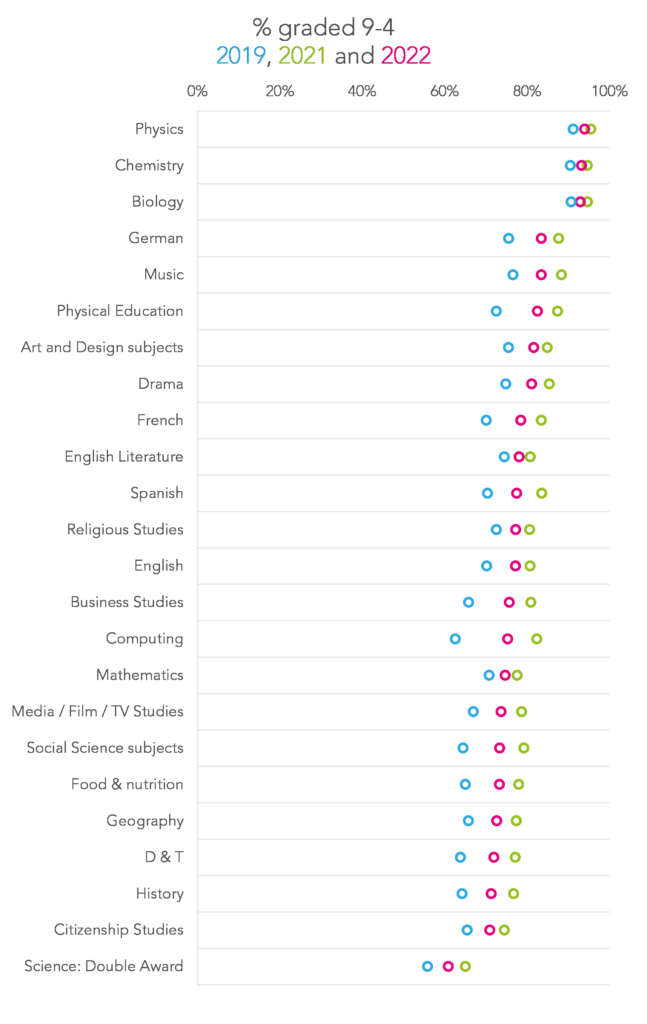
Why are entries in languages down?
In our preview post yesterday, we expected entries in modern foreign languages to increase.
Yet today’s data from JCQ suggests that, despite an increasing population, they have actually fallen in French, German and Spanish.
Ofqual’s provisional data for Summer 2022 entries states that there were 116,355 entries in Spanish by students of all ages in England in 2022. Yet the JCQ data says that were 107,488. We’d normally expect a bit of a difference (the Ofqual figures are provisional) but this seems fairly sizeable.
There has been a large fall in top grades at independent schools
The percentage of entries at independent schools awarded grades 9-7 in England increased by 14 percentage points between 2019 and 2021.
With the return to exams, this percentage fell by 8 percentage points.
By contrast, the percentage of grade 9-7 awards at schools classified as secondary selective fell by just 2 percentage points.
We previously expressed doubts about the increases in attainment at grade 7 and above in independent schools in 2020 and 2021. You can see these pieces here and here.
As a quick aside, JCQ and Ofqual use the National Centre Number (NCN) Register to classify schools rather than the Department for Education Get Information About Schools database. These are self-reported by centres. Selective academies have the option of classifying themselves as selective schools or academies. Consequently only 83 of the 164 selective schools in England are classified as such on the NCN.
Has the North-South gap increased?
As we showed in our preview post yesterday, pupil absence among Year 11 pupils was lowest in London during the pandemic.
Since 2019, the percentage of entries awarded grade 9-7 in the capital has increased by almost 7 percentage points compared to between 4 and 5 percentage points in most regions (North West, Yorkshire and Humber, East Midlands, West Midlands, East and South West).
It is also worth noting that attainment on this measure increased by 6 percentage points in the North East despite this region having the highest rates of absence for this cohort over the last two years. This was a similar increase to the South East, which had the second highest rate of absence (after the South West) for this cohort this year.
At the moment we’re dealing with very high level data published by JCQ and Ofqual. We’ll be saying more about the links between absence and attainment over the next week.
The National Reference Test showed a fall in performance in maths, but not in English
The National Reference Test (NRT) is a fairly new idea, with the first tests taking place in 2017. Briefly, a sample of Year 11 pupils take a set of English and maths tests in the spring before their GCSEs. If the results show that performance is higher or lower than usual, Ofqual can ask exam boards to adjust grade boundaries.
This year, Ofqual took the decision not to ask for any adjustments based on the NRT no matter what it showed. But the results are still interesting.
They show that performance in English was slightly lower this year than it was pre-pandemic, but official analysis shows that the difference is not statistically significant. But there was a significant fall in performance in maths.
This is yet another piece of evidence on how attainment, particularly in maths, has been negatively impacted by the pandemic.
We go into the results of the NRT in more detail here.
The gender gap hasn’t moved much, but boys are ahead for top grades in maths again
Girls tend to outperform boys on almost every metric at GCSE. Last year saw a widening of the gap at grades 9-7, and a narrowing at grades 9-4.
This year, the gap in top grades has narrowed slightly (from 9.2pp to 7.5pp), though remains wider than in 2019 (6.7pp). At 9-4, the gap has stayed roughly the same (6.8pp vs 6.9pp) and remains narrower than in 2019 (8.9pp).
2020 and 2021 saw a long-standing trend bucked: girls outperformed boys at the top grades in maths. This has been reversed this year, with boys achieving 0.8pp more 9-7 grades than girls.
The pass rate in English and maths for 17+ year olds is lower than in 2019
One area which has not followed the pattern of results falling between 2019 and 2021 is 9-4 grades in English and maths for older learners.
28.4% of 17+ year olds taking English this year received at least a grade 4 compared with 42.3% last year and 30.3% in 2019. The equivalent figures for maths are 20.1% this year, 38.6% last year and 21.2% in 2019.
This likely reflects differences in the prior attainment of this cohort compared with 2019’s. Proportionately more students would have achieved grade 4 or above through CAGs and TAGs in 2020 and 2021 and so would not have had to resit English and maths.
Want to stay up-to-date with the latest research from FFT Education Datalab? Sign up to Datalab’s mailing list to get notifications about new blogposts, or to receive the team’s half-termly newsletter.


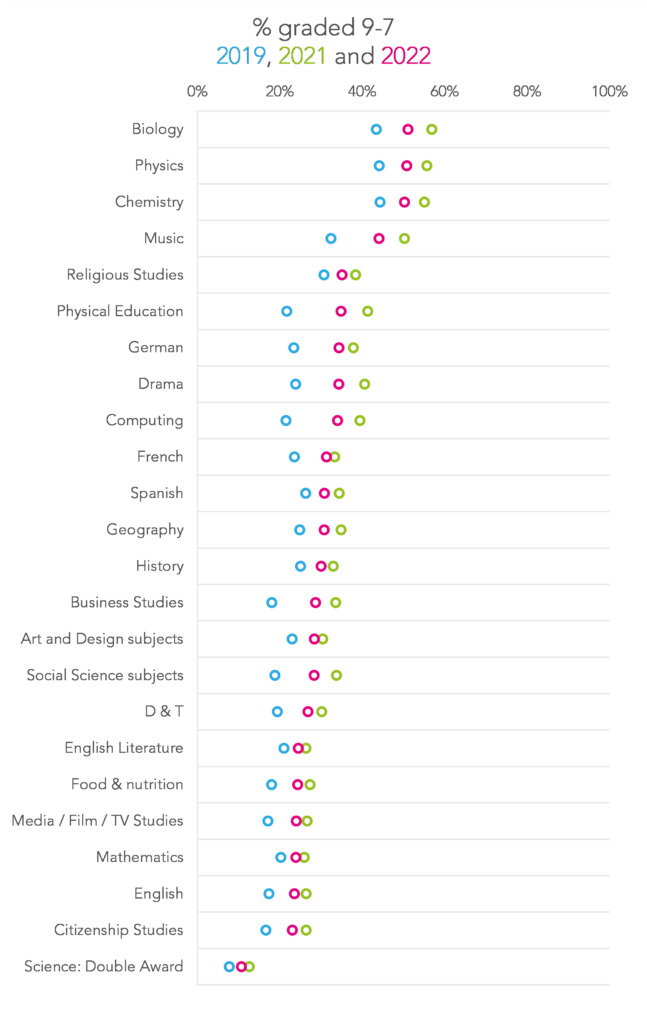
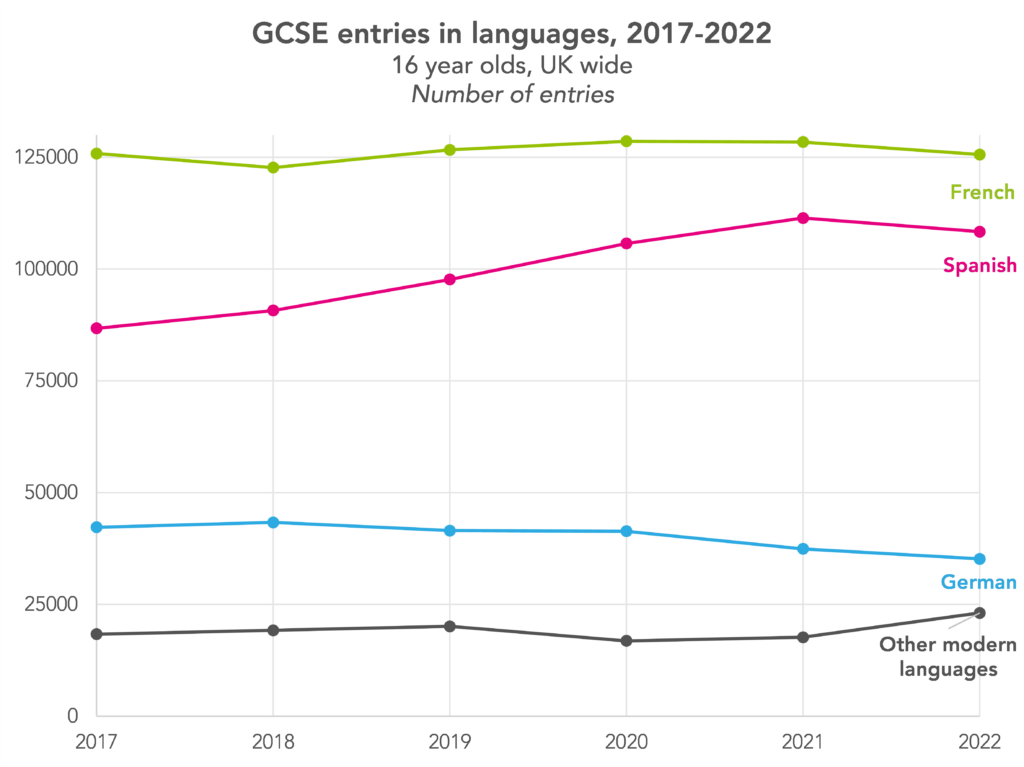
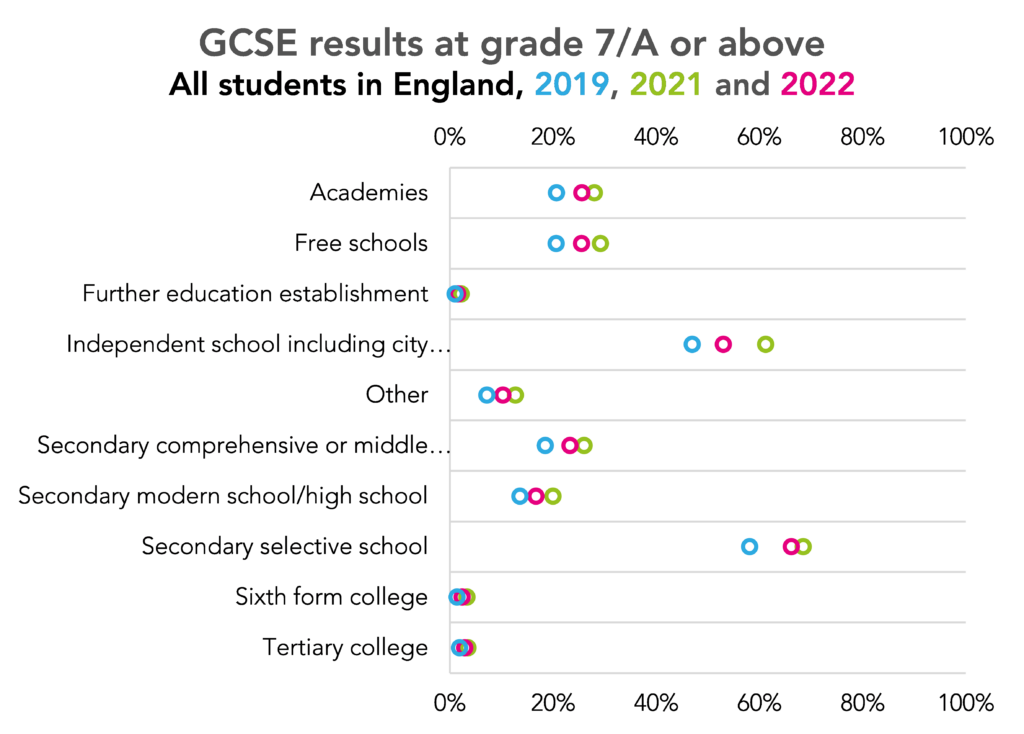



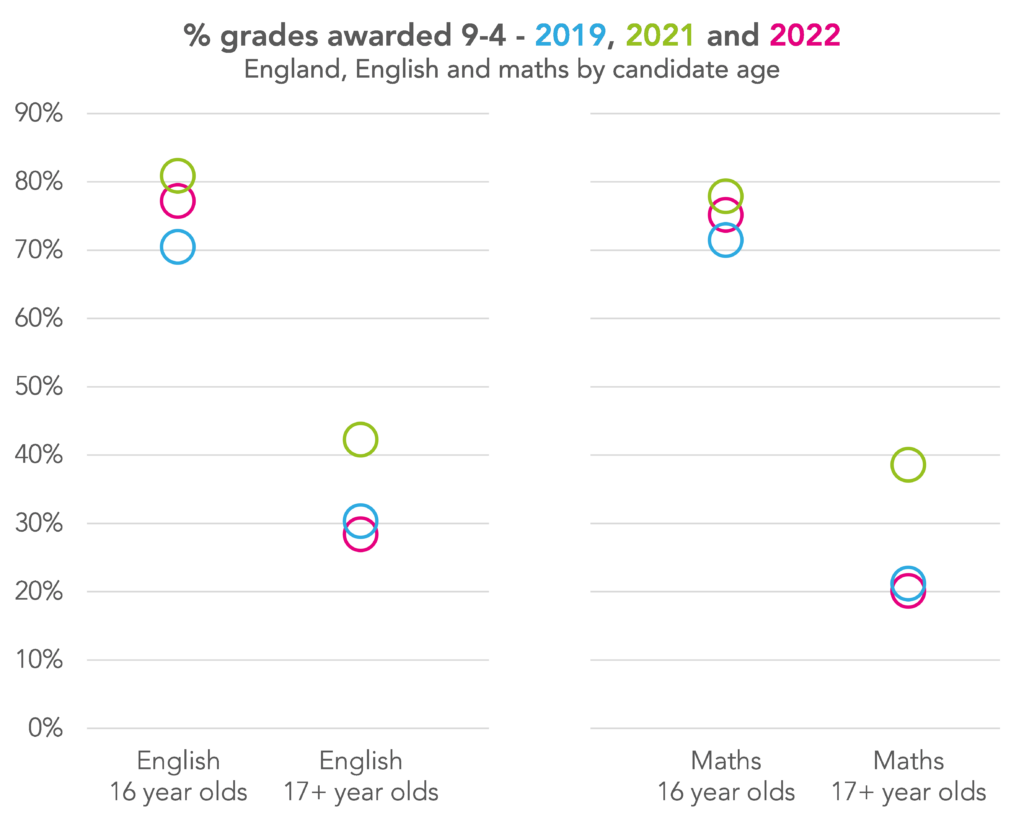





Please could you tell me where I can find national data which shows differences between different school types (academies, secondary modern etc.)?
Many thanks
James
Hi James. Try this https://analytics.ofqual.gov.uk/apps/GCSE/CentreType/
Thanks, combined with the A level data it backs up what I saw in our local schools in Kent. My local Selective Schools marked their GCSE’s reasonably in line with historical results but the same schools pushed up their A level grades a bit. The Secondary Moderns seemed much more inclined to push up their students for GCSE as they were more likely to be on the critical 3/4/5 boundaries.
The Independents seemed to push up the grades at both levels.
It’s interesting that the grades haven’t been dropped to the 2019-2021 mid point. Perhaps Ofqual thinks it is more expedient to reserve a bigger drop for next year, when the public is more used to, and more accepting of, grades dropping.
In any case, the debates about whether and how to drop grades to 2019 levels, as well as Ofqual finally admitting that 2020 and 2021 grades are not comparable to those of normal years, show that Ofqual was wrong not to use a different grading scale for 2020 and 2021. If apples are not comparable to oranges, it is wrong to disguise oranges as apples and pass them off as the same type of fruits to unsuspecting consumers.
Also possible they might buy themselves a bit more time (although they seemed to pour cold water on this yesterday). You may well be right about the second point- but I may be agreeing with the benefit of hindsight.
I think the the KS2 Maths and English also present a difference in falls with Maths being worse.
Hey, this article is great, big thanks for sharing it!
Can I use these statistics? Of course, I will site you!
Thanks Marie, that’s very kind! You’re welcome to quote the statistics shown here, if you could reference this post when you do we’d be grateful.
Was there a bigger drop than usual in students actually sitting examinations that they had been entered for/ You state on this site that it was 8% in MFL – is this the same for GCSE entries?